Arriving in Papua New Guinea – Lightning and Nissan Island
1Wednesday 29 July 2015
Sailing to our first destination in Papua New Guinea was a two day affair as we sought to stay clear of the troubled island of Bougainville. With our sea legs not quite re-established it was taking some adjusting to life on the rolling seas again. On this trip, bad luck would have it that we had current running against the wind resulting in some very sloppy rough seas at times and little sleep.
The other thing we have to get used to as we approach the equatorial belt is the lightning storms. With air and sea temperatures increasing, huge cumulonimbus clouds build and often these turn into big black squalls and worst of all lightning storms. On our second night we endured lightning all around us for six hours. Some of it pitched from cloud to cloud which we’ve learnt is a good thing as it neutralises the air, but then there were still many strikes going from the sky to the sea. We tried to watch which direction the storms were moving but soon realised the horizon all around us was just covered in lightning strikes. It put us on edge. Adina has various groundings but opinions are diverse on whether there is much you can really do to protect your boat. A lot of scientific evidence shows that any grounding cables cannot cope with the voltage delivered by a lightning strike and it’s just not your day if you get hit. We put what electronics we could in our oven and microwave which create Faraday cages and should in theory protect them. Then we did the best to get our own bodies out of danger, staying clear of any metal. And then wished for it all to go away!
We now have an El Nino declared for the year which has its good and bad elements for sailors. One consequence is that the south-east trade winds move further north which for us is a good thing as we approach the equator and the so-called doldrums where in a normal season the winds would die and we’d end up boosting the share price of BP and Shell. So we appreciated the wind, even if not the tide or lightning.
Papua New Guinea doesn’t have the greatest track record for security and general advice is to stick to the smaller outer islands where people are friendly and welcoming. We have chosen to hop along the five islands that extend along the east of New Ireland located to the east of Papua New Guinea. Our first stop was a small atoll called Nissan Island which our charts had positioned a mere 2.5 nautical miles out! More argument for downloading satellite images in advance, which we had done.
We slowed to time our arrival in daylight, rolling more and more as the wind stayed against tide. Finally with enough light we could see the passage we needed to enter. The passage in was 80m wide but at the entrance the tide was ripping. Be firm, be sure, look everywhere. Get through and vow you are having a strong gin and tonic that evening. We dropped the anchor, had breakfast and went to sleep for an hour!
It wasn’t long before the locals came out in their wooden outriggers bringing fruit and vegetables to trade. In fact it soon became a steady flow. We didn’t mind as we needed to stock up Adina’s pantry. But word gets out, we did one trade for some pants for children and out came more parents asking for pants. The hardest part is when you start to get a surplus of something, you so don’t want to turn people away empty handed but know you have more food than you can use. Soon Adina’s deck was awash in colour with all sorts of fresh fruit and vegetables.
The next morning we had arranged to go in and meet the chief and visit the school. Patrick Samuel, the chief, welcomed us as we came ashore. In many islands meeting the chief can be quite an occasion and like you would host at home, they too dress up in their best and chairs and tables are put out. We sat and chatted, leaving a small gift while he offered us fruit and nuts to take back with us.
The school visit was to the junior school for children under seven and much to our surprise they had arranged a little programme of singing for us. They stood in a circle and sang their hearts out including songs like ‘row your boat’ and ‘I’m a little teapot’. I’m not sure who was enjoying it more – them or us. Delightful and a trip highlight. The chief stood smiling proudly – we knew this was a well run village.
Further along was another yacht, belonging to an Australian called Andrew who had married a local girl and was putting down his roots with his wife and children. Sometimes we meet westerners who have moved to islands and, without meaning to be derogative, they have either escaped or just dropped out. Andrew was the opposite – he was putting his life and soul into getting established building a house, setting up a little business and all the time respectful of local customs and incorporating his vast PNG family. He’d bought in an Ikea assembled dining room table over from Australia and we were honoured to be able to join him and his family for their first meal at the table. But local life continues – he told us once we’d been invited a few of the locals were off finding a chicken to slaughter!
The next day we headed back to the village for a ‘Susie Clinic’ to help out with various ailments. We’d stocked up with medical supplies in Brisbane and now had a good supply of antibiotics and various bits and pieces for wounds. Our supplies also included heaps of toothpaste given to us by dentist Bill Kahler who had treated Tom in Brisbane. And there was a good queue. It takes the brave to be amongst the first patients as the rest try to assess whether it’s safe or not! Where we can help a lot is with wounds and cuts that have been infected. Whilst dressing the wounds on children we explain to parents how to clean them with rain water mixed with salt (to do the same thing as Betadine) and to keep them covered to protect from flies. The kids are always amazingly brave, smiling away – although there is the odd one that howls non-stop. The locals tell us “They are not used to your white skin”. We get many elder folks asking about sore knees, the result of many years of working in their gardens located far away, often up hills. And so we try to be positive explaining it’s merely old age and shows they have worked hard – all we can offer is a few anti-inflammatories to help when the pain is at its worst as we know they will continue to work in the gardens.
The chief had made some coconut oil and treated us to some locally made chips. Delicious. A final walk about past the junior school and we then sat watching the weekly volleyball competition which, admittedly different, made sense on an atoll where there was little space for such a thing as a football pitch. As we passed time a little child all on his own walked up to Susie, staring at her then kneeling down he pointed to his damaged toe and broken toenail with sore underneath. It was so touching; clearly he had seen her earlier and had come for help. Needless to say he got a little extra attention.
We’d really enjoyed Nissan Island. In one of the schools was a board about leadership, how leaders should set good examples, how people will follow good leaders. Patrick Samuel and his village was a shining example.

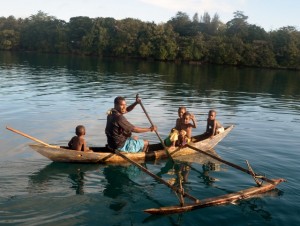
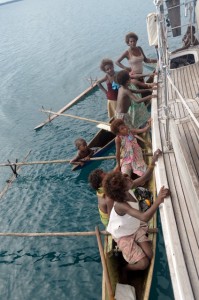
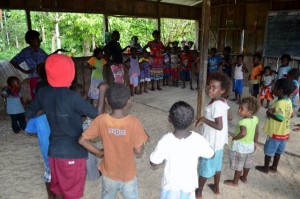
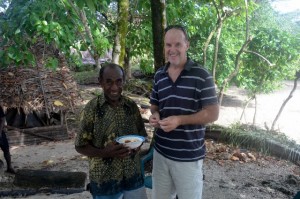
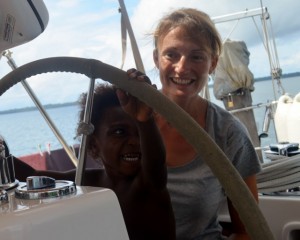
Thank you for sharing your wonderful experiences of travel through out Nissan PNG the world. The photos you posted are amazing! I am particularly interested in Nissan Island as I have been researching my Grand father who was born there and taken to Samoa during the early 1900’s as an indentured labourer. I have also been in contact with Andrew who you met with in Nissan. I am working to help organize shipment of laptops to Nissan Primary School for the children. I was wandering what is the name of the primary school there? Thank you again for sharing the beautiful photos of the locals there particularly the ones of all the smiling children. I hope to visit there one day with my own family.